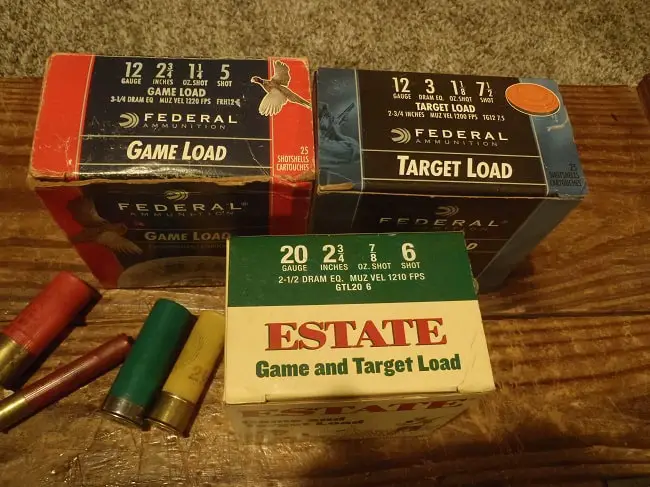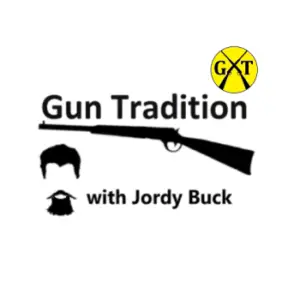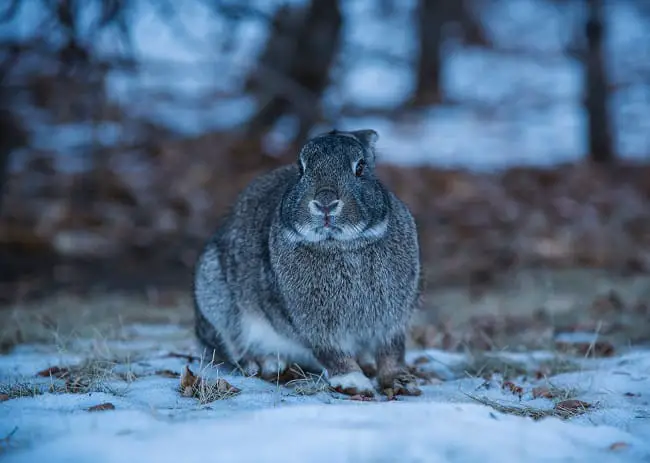Rabbit season opens two days after my birthday. It’s my annual tradition to spend go on a birthday bunny hunt and make some rabbit stew.
#6 lead and #4 steel in a 1-ounce or greater load is the best shot for rabbit hunting. Target loads in #7 ½ lead will work under 20-yards but #6 lead and #4 steel will have more downrange power while still keeping a full pattern.
If you’re asking about this, I bet you have more questions. I will go over shot size in more depth and cover other questions you probably have too. You’re gonna want to read to the end.
Best Shot Size for Hunting Rabbits?
Shotgun shot technically comes in sizes from teeny #12 to the large #1. However, not all of them are even produced. Some of them are quite hard to find. I’m going to stick with what I can find online or at a well-stocked gun store. Commonly available sizes are steel #4 and #6, and lead #7 ½, #6, and #5.
With lead shot, a 1-ounce load of between #7 ½ and #5 will generally yield desired results. With steel shot, you are basically limited to either #6 or #4 because they don’t really make #5 steel. Steel #6 is equivalent to lead 7 ½ in pattern density and pellet weight. Steel #4 is about the equivalent of Lead #5.

Most all the applicable ammo will be loaded with either steel or lead shot. steel is getting more popular because it’s the cheapest non-toxic metal to work with. Lead is slightly heavier, and steel is slightly more accurate. Both will work fine.
Because steel is lighter than lead, it takes more pellets of the same size to make an ounce. So a #6 steel load will have a fuller pattern (more pellets on target) than a load of lead #6. That’s good. What’s not so good about steel is that the pellets, while more, are lighter. Lighter pellets slow down faster.
They have lower sectional density, which means that they have a higher ratio of air resistance/kinetic energy. Slower velocity means the shot will play more in the wind, drop faster, and have less downrange energy. Steel has a somewhat shorter range than lead shot because of this, but it’s seldom a problem.
The smaller shot, #7 ½ lead or #6 steel, is an acceptable option and both are cheap. You can find them for under $10 a box in most gun stores. The larger shot, #5 lead, and #4 steel are good too and have about 10-15 yards more effective range than the smaller shot.
The lead #7 ½ and steel #6 are your basic target loads. They are cheap and plentiful. That’s the stuff you are most likely you find on the shelves at Walmart. The other shot sizes may require a trip to a sporting goods store to find.
Another option is lead #6. It’s a common small game load. It’s my personal favorite shot size for rabbits, squirrels, and grouse up to 30 yards with a modified choke. It’s a great option for general small game hunting at close range.
About size, we have to remember a few base rules. First up, the smaller the number, the bigger the size. Next and obvious, the bigger the size, the heavier each pellet. Also, the bigger the size, the less pellets of shot will be in the spread or pattern.
Here’s why that’s important. Heavier pellets will have more energy, which means it will shoot straighter and penetrate the target better. That’s a good thing, but it’s not everything. The vital points on a rabbit are pretty small. It takes a lot of pellets to be sure you get a quick kill.
To stop a rabbit, you need to take out its central nervous system. The rain on a rabbit is a little bigger than the size of a marble, and the spine is about as thick as a pencil. Those are small targets. You need a fairly full pattern and a well-centered hit to get your rabbit.
If we go too small, the pellets won’t have enough energy to do anything. We have to stay in the balance point of being most effective. With the lead shot, it’s around a #6 shot. now, #6 lead shot isn’t always that common. It’s also not usually the cheapest. That’s why most hunters go with the 7 ½.
7 ½ lead has its issues. It’s almost too small. However, it has a really superiorly full pattern. 7 ½ lead is a good compromise shot load for up-close rabbit hunting. The one caveat with it is like I said, it’s small and lightweight, so you can’t have an effective distance of all that far.
Just based on velocity and energy, 20 yards is pretty much the maximum distance for 7 ½ lead shot to work on a rabbit. That’s 60 feet. Sure, once in a while you could get one further, but it’s not a shot an ethical hunter should take. Disagree with me all you want
If you are a seasoned hunter, measure out 60 feet, then imagine a rabbit sitting on the other end. Most of the time folks will agree “yea, that’s almost a bit far”. Not that it can’t be done, but a lot of rabbits will get wounded and run away past that with #7 ½. You need it to fall dead right on the spot.

Non-Toxic Shot for Rabbit Hunting.
If the thought of lead shot causes concern, fret not. There are great non-toxic options.
The best non-toxic shot for rabbit hunting is steel #6 or #4, in a minimum one-ounce load with a velocity of at least 1,325 fps. Steel #6 is a 20-yard load while steel #4 is a 35-yard load.
Ever since federal law banned lead shot for certain hunting situations, there has been some call for non-toxic shot. In recent years, the demand is going up for non-toxic shot options. The first and cheapest option was steel shot. Steel has its problems, as do all of them.
When steel shot first came out, there were warnings from many shotgun manufacturers not to shoot steel down their barrels. They said that the steel shot would totally destroy the steel of the barrel. And that seems to make sense. Here’s why.
Steel will wear the bore of a shotgun. Shotguns made before 1950 should not fire steel shot because the older barrels were designed when the shot was only made of lead.
Non-toxic is generally steel, bismuth, tungsten, copper, or some combination of these. Copper is the softest, but hardly ever used. Steel is fairly hard, but it’s the lightest weight of the non-toxic shot. bismuth and tungsten are both hard and heavy, but quite expensive.
Steel is both highly functional and cheap. I know the old timer’s frown on steel shot, but I’ve been using it myself. It doesn’t have quite the range of the same size lead shot. due to the lower density of steel vs. lead, #6 steel shoots about like #7 ½ lead shot. Mabey just a tweak less powerful.
Super tip: Waterfowl loads are all non-toxic and often higher velocity than target loads or small game loads. Winchester XPERT HIGH-VELOCITY Steel shot is a 2 ¾ shell with over an ounce of steel going 1550 fps. It’s also fairly cheap. It’s available in a 1-ounce load of #4.

Shotshell Length for Rabbit Hunting.
Most modern shotguns will accommodate 3-inch shells. But most ammo available is 2-¾ inch. The length of the shell makes a big difference, even in what shot size to choose. With a longer shell, you can go with a larger shot size because there will still be enough pellets to fill the pattern
Most 12 gauge 2 ¾ target and small game loads have a velocity of around 1275 feet per second with a one-ounce load. The 3 inch can push almost twice the shot at that same speed. With a 3-inch shell, you have fewer options on store shelves, but more power.
If you are going with a 3-inch shotshell you can up the shot size to #5 lead with absolutely no concern, as long as you have at least an ounce and a quarter of shot in the shell. for non-toxic guys, you can probably go with #4, as long as you have over an ounce. Remember; bigger number, smaller shot size.
You may notice that I keep saying go with a larger pellet for steel than with lead. There’re two reasons why. I already said that steel needs bigger shot because steel is lighter than lead. But steel also shoots tighter groups than lead does. It’s true.
Lead shot, being very malleable, becomes deformed by the other pellets and spreads into a wider pattern downrange. Steel doesn’t do that, which is why it stays in a tighter pattern than lead. Because the pattern is tighter, we can get away with a slightly larger pellet size. The only difference is the smaller overall diameter of the pattern.
That’s why I like to grab a box of #6 steel high-velocity loads. Most guys usually reserve those for duck hunting because, for some reason, ducks are worth more than rabbits. It’s not a big cost difference. Most quality small game shotgun loads cost equal to the cost of the high-velocity steel shotshells.
These are usually under $15 for a box of 25 “waterfowl loads”. Just be sure you get #6 or #4 shot if you are using steel. Steel #4 is roughly equivalent to lead #5 ballistically. They have a similar pellet count per ounce and fairly similar individual pellet weight.
Best Shotgun Choke for Rabbit Hunting?
The best choke size for rabbits is a cylinder or modified choke. Full and extra-full choke is too tight a pattern for a running rabbit and should be avoided. There is little advantage to a choke tighter than modified when using proper shot sizes for rabbits. Choose cylinder or modified after patterning.
I’m a sucker for a full and extra full choke, mainly because I seem to like a challenge. The best choke size depends on exactly what shot size you use. See how this stuff all connects? I told you it really wasn’t that simple. I’ll make this part simpler anyway. If you only have a cylinder choke, you should probably stick with either #7 ½ lead or #6 steel shot.
That’s because of the expected density of the pattern. Cylinder is a 25-yard choke option. It’s the widest option, so you need the fullest pattern. With an improved choke, the next full step up, you can go with the smaller shot size, or you can shoot #6 lead or #4 steel. Improved is a 35-yard choke.
That’s based on a guess of how your shotgun will shoot. It’s a highly educated guess, but a guess nonetheless. you should pattern your shotgun to find your max distance with a particular load. To pattern, your shotgun, shoot at a large piece of cardboard with a dot in the middle. If you have any open space in your pattern the size of a baseball, you were too far for a rabbit.
You may have an improved-cylinder or improved-modified choke. Those are in-between size chokes. Us hunters apparently need more options than we know what to do with. If you have an improved-cylinder or improved-modified choke, I’d err on the side of a fuller pattern with the smaller shot size.
Although, you’ll probably be fine going with the larger size too. just pattern it at least twice to know what your max distance is. The most part of a successful shot is knowing your max distance and not going past it. That’s how to bag rabbits.
Most missed or wounded animals were simply shot at from too far away to make a clean kill. It’s okay to pass up on less-than-perfect shots. That’s part of being a good hunter. I learned a long time ago that if I only take the easy shots, I’ll get almost everything I shoot at. No shame in that.

